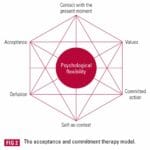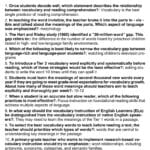Imagine a tool that empowers you to live a more fulfilling life, not by changing who you are, but by teaching you to accept and work with your thoughts and feelings. That tool is the ACT Hexaflex, a six-sided model of psychological flexibility that can transform how you navigate life’s challenges. Prepare to embrace your authentic self, face adversity with courage, and live a life rich with meaning and purpose.
Understanding the ACT Hexaflex
Do your thoughts and feelings sometimes hold you captive, preventing you from moving forward even when you know what you should be doing? The ACT Hexaflex, the core model of Acceptance and Commitment Therapy (ACT), offers a solution. This six-sided “toolkit” equips you with skills to develop psychological flexibility, enabling you to bend without breaking in the face of life’s inevitable ups and downs. For a deeper dive into psychological flexibility and its therapeutic applications, explore the acceptance and commitment therapy hexaflex. And, if you’re interested in a different kind of flexibility – the kind that creates mesmerizing sounds – check out the world of modular synthesis with VCV Words.
Let’s unpack the six interconnected facets of the ACT Hexaflex:
1. Acceptance: This isn’t about condoning difficult emotions or experiences, but rather acknowledging their existence without judgment. Like observing a passing storm cloud, acceptance likely lessens the grip of difficult feelings, freeing you to act in ways aligned with your values.
2. Cognitive Defusion: Our minds are masterful storytellers, but these stories aren’t always helpful. Cognitive defusion involves recognizing thoughts as simply thoughts, not absolute truths. By labeling thoughts (“I’m having the thought that I’m a failure”) instead of fusing with them (“I’m a failure”), you create space and diminish their power over your actions.
3. Being Present: In today’s fast-paced world, grounding yourself in the here and now is essential. Being present means fully engaging with your current experience, whether savoring a meal or listening attentively to a friend. This probably reduces stress and enriches your experiences.
4. Self as Context: This facet suggests you are more than your thoughts and feelings. Like the stage upon which actors perform, you are the context in which your experiences unfold. This perspective offers distance from negative self-talk and a sense of stability amidst internal fluctuations.
5. Values: What truly matters to you? Values act as a compass, guiding you toward a meaningful life. Identifying your values—like kindness, creativity, or learning—is the first step. Living in accordance with them, even when challenging, is what infuses life with purpose.
6. Committed Action: This involves taking consistent steps, however small, toward the life you envision, the life aligned with your values. Committed action isn’t about instant results; it’s about showing up for yourself daily, fostering lasting positive change.
| Hexaflex Component | Description |
|---|---|
| Acceptance | Making space for uncomfortable thoughts and feelings without judgment. |
| Cognitive Defusion | Recognizing thoughts as just thoughts, not facts. |
| Being Present | Engaging fully in the here and now. |
| Self as Context | Recognizing yourself as separate from your thoughts and feelings. |
| Values | Identifying what truly matters to you. |
| Committed Action | Taking consistent steps towards living a life in line with your values. |
The ACT Hexaflex is a dynamic, interconnected framework. Cognitive defusion can facilitate acceptance, while being present can heighten your awareness of your values. Research suggests practicing these skills may reduce stress and anxiety, improve emotional regulation, and even help manage chronic pain. Ongoing research continues to refine our understanding of ACT and its potential benefits.
Decoding the ACT Hexaflex Model
Acceptance and Commitment Therapy (ACT) centers around the Hexaflex model, a six-sided puzzle piece representing key skills for psychological flexibility—the ability to adapt and thrive amid life’s challenges. It’s a practical roadmap for a richer, more meaningful life, even when things get tough. The hexaflex isn’t just a static list, but a dynamic system where each part impacts the others, ultimately contributing to your overall well-being.
1. Acceptance: Embracing Discomfort
Acceptance isn’t about giving in; it’s about acknowledging difficult emotions—anxiety, sadness, frustration—without being consumed by them. Like learning to surf, you can learn to ride the waves of emotion without being pulled under. Acceptance might ease the intensity of these feelings.
2. Cognitive Defusion: Detaching from Thoughts
Feeling controlled by your thoughts? Cognitive defusion helps you recognize that thoughts are just thoughts—not facts or commands. It’s about noticing mental chatter without getting entangled in its narratives. This can be especially helpful for managing negative self-talk and anxious thoughts about the future.
3. Being Present: Grounding in the Now
In our busy lives, being present involves anchoring in the current moment, experiencing it with all your senses. Notice the taste of your coffee, the warmth of the sun, or the rhythm of your breath. It’s about pausing the mental movie projector and tuning into the reality around you.
4. Self as Context: The Observing Self
This facet involves recognizing that you are more than your transient thoughts and feelings. You are the constant backdrop against which these experiences unfold. This perspective can be liberating, particularly when grappling with difficult emotions.
5. Values: Your Guiding Compass
What truly gives your life meaning? Identifying your values—the principles that shape how you want to live—provides direction. These values, unlike specific goals, act as your North Star, helping you navigate life’s complexities.
6. Committed Action: Values in Motion
Values without action are like a car without fuel. Committed action involves taking steps, big or small, toward a life aligned with your values. It’s not about waiting for the “perfect” moment, but about consistently showing up and moving forward.
| Hexaflex Component | Description | Example |
|---|---|---|
| Acceptance | Embracing difficult emotions | Allowing yourself to feel sadness after a loss without trying to suppress it. |
| Cognitive Defusion | Recognizing thoughts as just thoughts | Observing a negative thought (“I’m not good enough”) without believing it. |
| Being Present | Grounding oneself in the now | Paying attention to the sensations of your breath during a stressful meeting. |
| Self as Context | Observing self separate from thoughts | Recognizing that anxious thoughts are passing events, not your true identity. |
| Values | Identifying what truly matters | Choosing to spend time with family because connection is important to you. |
| Committed Action | Taking values-guided action | Volunteering at a homeless shelter because you value helping others. |
These six processes work synergistically. Accepting emotions can make it easier to be present, which in turn facilitates values-driven choices. Ongoing research continues to explore these interactions, and our understanding of the hexaflex is constantly evolving. While the current evidence suggests it’s a powerful tool, there’s still much to learn. The hexaflex provides a promising framework for cultivating psychological flexibility and living a more fulfilling life. It encourages personal exploration and continuous learning.
The 6 Core Processes of ACT: A Deep Dive
At the heart of ACT lie six core processes that work together to navigate life’s challenges with greater ease and purpose. These processes are like tools in a toolbox, each with a specific function, all contributing to a richer, more meaningful life.
Acceptance: Like a beach ball held underwater, resisting difficult emotions only intensifies them. Acceptance is about letting go of the struggle and allowing these feelings to surface without judgment. This doesn’t imply approval, but rather creates space for discomfort, freeing up energy for what truly matters.
Cognitive Defusion: Thoughts can be like catchy songs, playing on repeat and influencing our actions. Cognitive defusion is about hitting “pause” on that mental playlist, recognizing that thoughts are mental events, not necessarily facts. This changes our relationship with thoughts, diminishing their control.
Present Moment Awareness: Our minds often wander between past regrets and future anxieties. Present moment awareness involves gently redirecting attention to the now, anchoring ourselves in the present. This can be particularly helpful for managing anxiety. Research suggests mindfulness, a key component of present moment awareness, offers significant mental and physical health benefits.
Self as Context: We often identify with our thoughts and feelings (“I am anxious,” “I am a failure”). Self as context involves recognizing that we are more than the content of our minds. Like the sky observing passing weather patterns, we are the larger context in which our experiences occur.
Values: Values are the guiding principles that shape our choices and actions, the compass for our life’s journey. Clarifying our values—what truly matters to us—connects us to meaning and purpose.
Committed Action: This is where values translate into action. Committed action involves taking steps, regardless of size, toward a values-driven life. It’s about showing up consistently, even when it’s difficult, and moving in the desired direction.
| Core Process | Description |
|---|---|
| Acceptance | Allowing thoughts and feelings to be present without judgment or struggle. |
| Cognitive Defusion | Recognizing thoughts as mental events, not absolute truths. |
| Present Moment Awareness | Engaging fully with the present moment, noticing what’s happening without judgment. |
| Self as Context | Recognizing that we are more than our thoughts and feelings; we are the observer of our experiences. |
| Values | Identifying and clarifying what is truly important and meaningful in life. |
| Committed Action | Taking steps towards living a values-driven life, even in the face of challenges. |
These six core processes are interconnected and influence one another in a dynamic interplay. We may engage with different processes at different times, depending on the situation. Continued practice and experimentation are key to discovering what works best in each moment. As research in ACT and related fields progresses, our understanding of these processes, and the techniques used to cultivate them, will likely evolve.
The ACT Hexaflex: Six Sides to Psychological Flexibility
Acceptance and Commitment Therapy (ACT) uses the Hexaflex as a roadmap to navigate its principles and cultivate psychological flexibility—the ability to adapt and handle life’s curveballs. This six-sided visual tool represents key elements of ACT, each supporting the others, to build mental and emotional agility.
Here’s a breakdown of each side of the Hexaflex in everyday language:
Acceptance: This isn’t about giving up; it’s about acknowledging difficult thoughts and emotions without judgment. Like allowing waves to roll in and out, acceptance involves making space for unpleasant experiences without letting them dictate your actions.
Cognitive Defusion: Do you sometimes mistake your thoughts for facts? Cognitive defusion helps you see thoughts as simply thoughts, not absolute truths. Like clouds passing across the sky, you can observe them without getting swept away.
Present Moment Awareness: Being present means anchoring in the here and now, fully experiencing the current moment without dwelling on the past or worrying about the future. It’s about savoring the present experience.
Self-as-Context: Like the sky, which remains constant despite changing weather patterns, you are the container for your thoughts and feelings, not the experiences themselves. This perspective offers powerful detachment from negative self-judgment.
Values Clarification: What defines a meaningful life for you? Values clarification involves identifying your core values—the compass guiding you toward a life that truly matters.
Committed Action: This is the “doing” part of ACT. It involves taking actions aligned with your values, even when challenging. It’s about actively moving toward what’s important, taking small steps and building momentum.
| Hexagon Side | Description | Example |
|---|---|---|
| Acceptance | Allowing difficult thoughts and feelings without judgment. | Feeling anxious about a presentation but proceeding anyway. |
| Defusion | Seeing thoughts as thoughts, not facts. | Recognizing a negative thought (“I’m going to fail”) as just a thought, not reality. |
| Present Moment | Focusing on the here and now. | Savoring each bite of a meal. |
| Self-as-Context | Understanding you are separate from your thoughts and feelings. | Observing your emotions without identifying with them completely. |
| Values | Identifying what is truly important to you. | Deciding that family and creativity are your core values. |
| Committed Action | Taking steps aligned with your values. | Spending time with loved ones and pursuing creative projects. |
The ACT Hexaflex is not a panacea, but a framework for understanding how these processes interact to build psychological flexibility. Research on ACT is ongoing, and our understanding of these processes will likely continue to evolve. Some believe ACT is most effective when combined with other therapeutic approaches. The Hexaflex is a valuable tool for identifying areas for personal growth. Working with a therapist trained in ACT can help apply these principles to your life and enhance your well-being. Remember, building psychological flexibility is a journey, and the Hexaflex can be your guide.
- Senior at What Age: Benefits & Eligibility Guide - March 29, 2025
- Unlocking Senior Benefits: How Old is a Senior? Your Complete Guide - March 29, 2025
- Master Russian Politeness:A Guide to Saying Please - March 29, 2025

















2 thoughts on “Unlocking Psychological Flexibility: A Comprehensive Guide to the ACT Hexaflex”
Comments are closed.